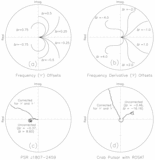Fourier Techniques for Very Long Astrophysical Time-Series Analysis
Abstract
We present an assortment of both standard and advanced Fourier techniques that are useful in the analysis of astrophysical time series of very long duration-where the observation time is much greater than the time resolution of the individual data points. We begin by reviewing the operational characteristics of Fourier transforms of time-series data, including power-spectral statistics, discussing some of the differences between analyses of binned data, sampled data, and event data, and we briefly discuss algorithms for calculating discrete Fourier transforms (DFTs) of very long time series. We then discuss the response of DFTs to periodic signals and present techniques to recover Fourier amplitude ``lost'' during simple traditional analyses if the periodicities change frequency during the observation. These techniques include Fourier interpolation, which allows us to correct the response for signals that occur between Fourier frequency bins. We then present techniques for estimating additional signal properties such as the signal's centroid and duration in time, the first and second derivatives of the frequency, the pulsed fraction, and an overall estimate of the significance of a detection. Finally, we present a recipe for a basic but thorough Fourier analysis of a time series for well-behaved pulsations.
- Publication:
-
The Astronomical Journal
- Pub Date:
- September 2002
- DOI:
- 10.1086/342285
- arXiv:
- arXiv:astro-ph/0204349
- Bibcode:
- 2002AJ....124.1788R
- Keywords:
-
- Methods: Data Analysis;
- Stars: Pulsars: General;
- Astrophysics
- E-Print:
- 38 pages. Submitted to The Astronomical Journal
